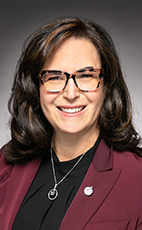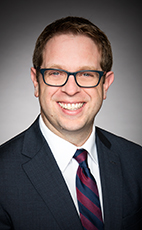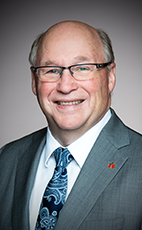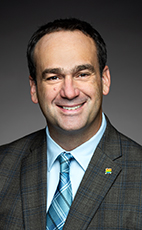44th Parl. 1st Sess.
May 29, 2024 02:00PM
- May/29/24 7:57:56 p.m.
- Watch
Mr. Speaker, leading addiction physicians from across Canada have written several letters demanding the minister make all safe supply programs witnessed and recovery-focused, or shut them down. Will the minister follow the advice from these experts?
37 words
- Hear!
- Rabble!
- add
- star_border
- share
- May/29/24 8:20:28 p.m.
- Watch
Mr. Speaker, I would just like to note that in the initial part of this debate this evening, we heard very stigmatizing language from across the bench, with the insinuation that all people who suffer from substance use are violent and a threat to society and are essentially criminals. I do not understand why they are criminalizing people's loved ones when they need health care and health services.
Prescribed alternatives are done under the strict authorization of medical providers and health experts. It is a sacred relationship between a patient and their physician to move them toward a place of health. We need to open the door to safety for those who use substances and are struggling with addiction, and prescribed alternatives are just one tool of a robust set of tools. The opposition pits harm reduction against treatment rather than looking at a holistic and compassionate approach to those who use substances.
154 words
- Hear!
- Rabble!
- add
- star_border
- share
- May/29/24 9:24:48 p.m.
- Watch
Mr. Speaker, I will be directing my questions to the Minister of Mental Health and Addictions.
In Belleville, Ontario, and surrounding Bay of Quinte, is there adequate funding and resources for addictions and essential addiction management?
36 words
- Hear!
- Rabble!
- add
- star_border
- share
- May/29/24 9:26:58 p.m.
- Watch
Mr. Speaker, can the minister state how many bed-based addiction treatment services are in the region?
17 words
- Hear!
- Rabble!
- add
- star_border
- share
- May/29/24 9:28:50 p.m.
- Watch
Mr. Speaker, is the minister aware of the average wait time for residential addiction treatment and supportive recovery programs?
19 words
- Hear!
- Rabble!
- add
- star_border
- share
- May/29/24 9:41:41 p.m.
- Watch
Madam Chair, I have been hearing a question to the Minister of Health again. I have been listening with interest throughout this debate, and I take the Conservatives at their word that they are concerned about the opioid crisis. They are seeing it in their communities, as we are seeing it in all of our communities, affecting people across the community.
I went on a ride-along with my local fire department, and we got a call: vital signs absent. We raced down to Montebello Park. The image that burns into my brain is the legs of a resident of St. Catharines sticking out of the stall in the washroom in Montebello Park. Paramedics brought that person back, as paramedics, firefighters and first responders are heroically doing across the country.
However, I was wondering if the minister could comment on what we are hearing in response to what I believe is health care: addiction and mental health. I know the Conservatives say that it is health care, but what I am hearing is just a repackaged version of what we tried in the seventies, eighties and nineties, which was “Just say no”. The Minister of Health talked about Newt Gingrich and the common-sense revolution, the harsh law-and-order penalties. We have tried to solve this as a society, through—
224 words
- Hear!
- Rabble!
- add
- star_border
- share
- May/29/24 9:53:38 p.m.
- Watch
Madam Chair, I think we should take that as a no.
September 2023, the minister received a letter from 17 addiction medicine doctors who said, “We are regularly seeing and hearing in our practices that diverted hydromorphone is causing harm to both adults and children.”
Does the minister agree with that statement?
54 words
- Hear!
- Rabble!
- add
- star_border
- share
- May/29/24 9:59:18 p.m.
- Watch
Madam Chair, does the minister believe that recovery from addiction is always possible?
13 words
- Hear!
- Rabble!
- add
- star_border
- share
- May/29/24 10:33:46 p.m.
- Watch
Madam Chair, I will start by talking, and then I will have some questions for the Minister of Mental Health and Addictions. I will let you know at the outset that I do not expect you to limit the time for responses to the time of my questions, if you would allow that.
I talked, in my first intervention this evening, about the common-sense revolution of Mike Harris and what that did for health care. This time I want to talk about the war on drugs in the 1980s and how successful that was. The reason I want to do that is that it is very clear the Conservative approach to drug policy is very similar to the 1980s approach to the war on drugs.
I was probably between the ages of eight and let us say 12 during Nancy Reagan's big push for “Just Say No.” It was Nancy Reagan, the First Lady of the United States, President Reagan's wife, who was leading the charge on the new-found approach to dealing with drugs, which was to just say no. How hard is it? All one has to do is just say no, and it is done. One does not have to worry about any of the problems that are associated with drugs.
That was, on the surface, what the issue was about, and that is, on the surface, how the Conservatives want to approach the current epidemics and issues with drug usage. However, under the surface of the war on drugs, something else was going on, which was a war against particular individuals in society who were being cast as problematic individuals who could not abide by the law. They were cast as people who were utilizing drugs based on just their own desire to do so, even though, according to the war on drugs, they could have stopped at any time they wanted. We all know that is not true.
What it did was that it took a policy approach of criminalizing to the maximum degree possible. In the United States, three strikes of simple possession of marijuana in some states would land someone in prison. There were situations where vast numbers of people were rounded up and incarcerated as a result of drug usage, quite often because it was something they could not control. For an individual who has an addiction, it is not as simple as to just say, “No, I do not want that.”
I speak as somebody who has experience of having lived with somebody with an addiction, somebody who is no longer with us. She passed away. When I was a city councillor in the city of Kingston, my partner at the time, whom I lived with, was addicted to alcohol. Ultimately she ended up dying as a result of her addiction.
One might ask why she did not just stop drinking. It is that simple, is it not? I remember having numerous conversations with her about it. I remember her going into the hospital, Kingston General Hospital, which would hold someone for 72 hours before letting them out. I remember her trying repeatedly on her own, and going to special places where people would try to help her with her addiction. It did not matter. She kept going back to the place of using in order to support her addiction because it provided a certain level of comfort and because it was helping her deal with other problems she had previously had in her life. It was mental health.
At the core of the issue is how one treats an addiction. Does one treat an addiction for the mental health crisis that it is, or does one treat it as a criminal offence and treat it how Conservatives want to treat mental health and addictions, which is by telling people that all they have to do is just say no, and if they do not, that they are going to go to prison? That is the approach of the Conservatives. It is a failed approach and an approach we know does not work.
My friend Kate, my partner at the time, is no longer with us. She eventually ended up getting to a point where she passed away, and she had been deceased for over a week before anybody discovered her. Because of the addictions that she had, she had pushed everybody out of her life.
We can approach this by just asking why Kate did not just say no and stop drinking. We can ask why these drug users will not just stop using; it is that easy. Otherwise, we can treat it as the real problem it is. We can treat addictions as the real issues and the real mental health challenges that they are.
I know first-hand that trying to cut people off is never the solution, and it never works. That is why I am very proud to sit on a side of the House that treats mental health and addictions as the real health challenges that they are.
I am very concerned when I hear Conservatives harking back to the days of Nancy Reagan as though that approach could work today when it did not work before. It is really important that we do things from an evidence-based approach, which is why I am glad to see our government and the minister, in particular, doing that.
I have some questions for the minister that I would like to turn to now.
Conservatives talk about investing in treatment, but they cut two-thirds of drug treatment funds when they were last in government.
Let us talk about what saves lives, such as safe consumption sites. There is a safe consumption site in Kingston. We have not had an overdose crisis similar to the one that my neighbouring community in Belleville witnessed recently. I like to think it is because there was a safe consumption site in Kingston. We also have other health care services, such as prevention, treatment and harm reduction.
Can the minister please tell us about how we are supporting life-saving actions instead of slogans?
1030 words
- Hear!
- Rabble!
- add
- star_border
- share
- May/29/24 10:41:15 p.m.
- Watch
- Re: Bill C-5
Madam Chair, on the other side of the House, they roll out slogans that are literally written on the back of a napkin, rather than talking to experts or speaking to families and communities about what truly needs to be done to address this crisis. Their solution is criminalizing their loved ones. To that, I say that we cannot arrest our way out of a health crisis, and we are in a health crisis. People are dying and families are losing loved ones. We have to open the door for those loved ones who are struggling with addiction. They cannot just snap their fingers and get there. We need to give them a pathway to safety, one that is compassionate and based on evidence.
We know that safe consumption sites save lives. Over 55,000 overdoses have been overturned at safe consumption sites. That is 55,000 lives saved and over 471,000 referrals from safe consumption sites to treatment options. Those 471,000 lives were given a pathway to make better choices for themselves, to get help with their addiction. We cannot look away. Safe consumption sites in communities that are well managed and well resourced mean that we are meeting people where they are. We are not judging them, not stigmatizing them, not telling them to go to a back alley to shoot up and die. Rather, we would say, “Come on inside. Let me help you. Let's talk about it. I see you in your struggle.”
On that side of the House, they pit harm reduction against treatment. This is not an either-or debate. This is about saving lives. We have all lost someone. I have lost a dear friend to an overdose, someone who I knew all my life. Every resource was made available to him, and he died alone, leaving two beautiful children and a wife behind.
I am a mother. I worry about my kids. We all worry about our young people. That is why prevention is so important. That is why we have the no opioids program and the ease the burden program for our tradespeople. We are doing the work with jurisdictions in every community that we can. If anyone wants help in this country, we are there for them. That is why we have the ETF of $150 million in budget 2024. That is $150 million over the next three years for communities, indigenous communities and municipalities that need our help. On top of that, there is $200 billion in bilateral agreements, where over 30% on average is for mental health and substance use. This is on top of the health transfers because there is not one silver bullet to this.
Treatment is not the only answer. We have to get people to treatment. We cannot treat someone if they are dead. We cannot treat someone if they are dying at home alone, in a back alley, or on the streets of many communities in this country. We are losing people because there is a toxic, poisoned drug supply. That is where enforcement comes in with our pillars, and that is why we work with law enforcement. However, law enforcement is asking us to stand up in our communities to work with evidence, to work with experts, to work with peer support workers, outreach workers and health care workers to save lives.
It is uncomfortable to see someone struggle with addiction. Seeing someone in their most vulnerable and worst moment is painful, but on this side of the House, a comprehensive approach says that even if it is hard, even if it is uncomfortable, even if it is difficult, we do not look away. We meet the moment. We meet the challenge. We have spent a billion dollars since 2017, as opposed to the two-third cuts that were put in place under the previous government.
We know that it is not just about throwing money at this. It is about building the systems that we need with provincial partners who are responsible for health because this is a public health crisis. This is not a criminal one. That is why we put into place bills such as Bill C-5, to ensure that we are moving people out of the criminal justice system into health care and into supportive environments. Why is that? It is because we care.
Governments are meant to invest in their people. That is what we do on this side of the House: We invest in people. We do not cut. We do not look away. We say we are going to find the tools so that people can live one more day, and we can show them a pathway forward and a way to get the health care they need. Someone will address that wound. Someone will lead them to the supports that they need, but we have to invest in them.
Harm reduction is a key part of that process. To pit harm reduction against treatment is to say it is either-or, it is all or nothing, it is black or white, and it just takes treatment. It means that they are not seeing the person in front of them and the health and services they need. On this side of the House, for every single one of us who has lost a loved one to this opioid crisis and who wants communities and young people to be safe, we need to invest in a strategy that we know works. That is prevention, harm reduction, treatment, recovery and, yes, enforcement too. Public safety and public health go hand in hand.
We will not look away. I will not look away from the people who know we can save their lives, whether it is with naloxone kits, drug checking or safe consumption sites. We know that, when we close safe consumption sites, overdose deaths go up because people go back into the shadows. We want to bring people into the light. We want them to know that they are going to see another day and that we are investing in them because they matter.
That is the work we are doing. That is what I invite every member of the House to stand up for and support. The Nimbyism, the slogans, the fear and the stigma we are seeing on the other side will just put people back in the shadows. I want us to see the light.
1078 words
- Hear!
- Rabble!
- add
- star_border
- share
- May/29/24 11:47:13 p.m.
- Watch
Madam Chair, I thank the Minister of Indigenous Services for her compassion. It is so important for us to remember what it means to be Canadian right now. We hold each other together, and we are holding each other through many challenging things right now, including the tragic lives lost through the overdose crisis. This is where we step up and throw everything we have got at it.
What is amazing about harm reduction and needle exchange is that it is not new. It has been around as an evidence-based, proven way to meet people where they are at, to open the door for them to come inside and get help. When people offer an extended hand and say to come on inside and ask what someone needs, what is the first thing someone needs? They need a clean needle. Let us talk about why they are using that needle. Let us talk about how we get them to a healthier place. Harm reduction is nothing new.
On the other side of the bench, they stigmatize. They talk about this in terms of their loved ones being criminals, that they should go back to dark corners and hide what they are struggling with, hide their struggle with substance use and the disease of addiction. We know that needle exchanges and safe consumption sites bring people into health care. They walk into that place. We are not just talking about saving lives. We are talking about getting them the health services they need with the compassion and care that they deserve.
261 words
- Hear!
- Rabble!
- add
- star_border
- share
- menumenu
- notificationsnotifications
- home
- mailmail
- searchsearch









